Introduction
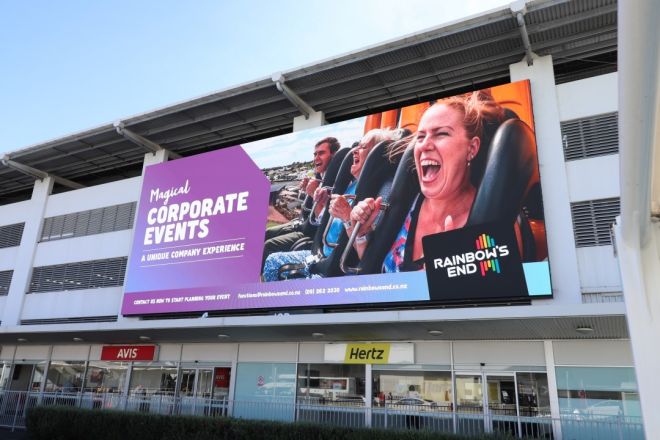
Does having an LED display screen mean that you are already at the forefront of visual communication?
But in the face of a dazzling sea of screens, how can your LED display screen become the most dazzling light? Have you ever been confused about how to increase its exposure so that more people will notice and remember it?
This article is designed to solve these questions. We will directly explore how to make your LED display screen stand out from the ordinary by formulating effective marketing strategies, and become a tool to attract attention and deliver value.
Whether you want to enhance your brand image or maximize your commercial value, this article will provide you with practical strategies and ideas to help you.
1. Why do you want to market LED display screens?
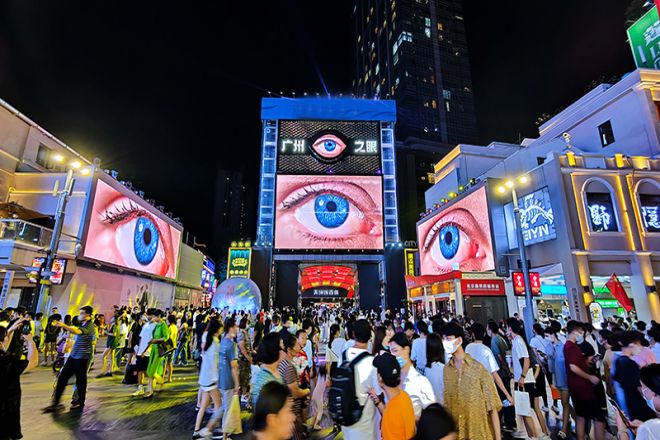
The marketing of LED display screens is mainly based on their unique media characteristics and wide communication effects. Doing so can bring many benefits, including:
1). Enhance brand exposure:
The high brightness and large screen characteristics of LED display screens make the advertising content visually very impactful and can quickly attract the attention of passers-by and viewers. This high visibility greatly enhances brand exposure and enables brand information to be quickly conveyed to the target audience.
2). Enhance brand image:
By displaying high-quality and creative advertising content on LED screens, brands can create a more professional and high-end image. This image enhancement helps to enhance consumers’ trust and goodwill in the brand, thereby promoting the formation of brand loyalty.
3). Promote sales growth:
LED screen advertising can directly guide consumers to pay attention to the brand, understand product information, and stimulate their desire to buy.
Especially during promotional activities, by displaying preferential information, limited-time discounts and other content, it can significantly promote sales conversion and drive sales growth.
4). Accurately locate the target audience:
LED screens are usually installed in areas with large traffic and concentrated target consumer groups, which enables marketing activities to reach the target audience more accurately.
Through precise positioning, brands can convey advertising information more effectively and improve the reach and conversion rate of advertising.
5). Improve advertising interactivity:
Modern LED screens support a variety of interactive functions, such as scanning codes to follow, receiving coupons, etc.
These interactive functions can enhance the interactivity and participation of advertising, allowing consumers to participate in brand activities more actively, thereby deepening their impression and memory of the brand.
6). Real-time update and flexibility:
LED display advertising content can be remotely controlled and updated instantly, which enables brands to quickly respond to market changes, launch new advertising content, or adjust marketing strategies.
This flexibility helps brands maintain the timeliness and pertinence of advertising and ensures the effective communication of advertising information.
7). Data support and effect evaluation:
LED display management systems usually have data analysis and effect evaluation functions, which can monitor advertising playback, audience feedback and other data in real time.
These data provide brands with valuable market intelligence and decision-making basis, which helps brands evaluate advertising effects, optimize marketing strategies and improve return on investment.
2. 4 Steps to Develop LED Display Marketing Strategy
When formulating an LED display marketing strategy, linking festivals or popular IPs and creating attractive content based on current trends is a very effective way to quickly attract the attention of target audiences. Here are some specific strategic suggestions:
1). Festival theme marketing
Creating a festival atmosphere: According to different festivals (such as Spring Festival, Mid-Autumn Festival, Christmas, etc.), design corresponding visual elements and atmospheres to make LED display screens part of the festival atmosphere.
Special festival events: Combine the characteristics of festivals to plan interactive games, lucky draws or limited-time discounts, etc., encourage audiences to participate and share on social media to expand the scope of publicity.
Festival storytelling: Tell stories or legends related to festivals through LED display screens to increase the cultural connotation and emotional resonance of the content.
2). Popular IP cooperation
IP image display: Cooperate with popular animation, movies, games, and other IPs to integrate IP images into LED display screen advertisements to attract fans’ attention and discussion.
Joint promotion activities: Plan online and offline joint promotion activities with IP parties, such as new product launches, theme exhibitions, fan meetings, etc., to increase brand exposure and participation.
Creative content development: Based on IP stories and characters, develop creative advertising content, such as animated shorts, interactive plots, etc., to enhance the fun and appeal of advertisements.
3). Current trend marketing
Hot spot tracking: Pay close attention to hot topics and popular trends on social media, news websites, and other channels, and adjust advertising content in a timely manner to meet current trends.
Trend element integration: Incorporate fashion elements, buzzwords, popular music, etc., into advertising design to make advertising content closer to the aesthetics and interests of young audiences.
Innovative content forms: Try to use new content forms, such as short videos, live broadcasts, VR/AR experiences, etc., to display products or services in a more vivid and intuitive way.
4). Cross-border cooperation and creative linkage
Cross-border brand cooperation: Cross-border cooperation with other well-known brands in the industry, jointly launch joint products or activities, and display the results and highlights of cooperation through LED screens.
Creative linkage activities: Cooperate with artists, designers, Internet celebrities, etc., to hold creative linkage activities, such as art exhibitions, fashion shows, etc., and use their influence and creativity to enhance brand image and popularity.
3. Sharing of successful marketing cases of LED screens
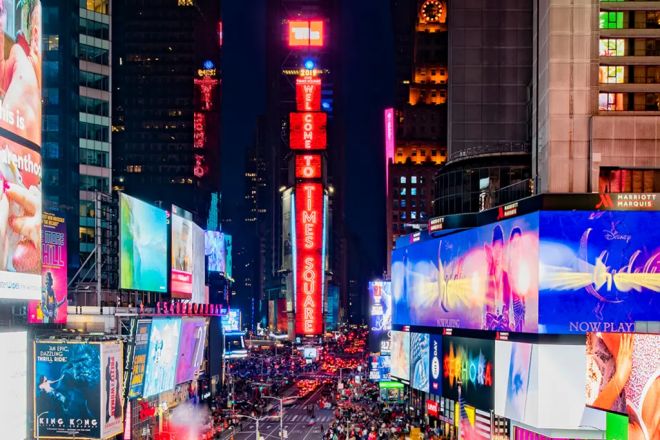
1). LED large screen marketing for New York Times Square New Year’s Eve celebration
1.1). Success factors:
Global attention: As a world-famous landmark, New York Times Square’s New Year’s Eve celebration has attracted the attention of hundreds of millions of viewers around the world, providing unparalleled exposure opportunities for LED large-screen marketing.
Creative content: The carefully designed advertising content of major brands, combined with dynamic videos, special effects and real-time data display, creates a shocking visual effect and attracts a lot of eyeballs.
Precise positioning: The brand customized the advertising content to match the brand image and festival theme according to the preferences of the target audience and the festival atmosphere, which enhanced the pertinence and attractiveness of the advertisement.
1.2). Implementation process:
Advance planning: The brand and the advertising company planned the advertising content and delivery time several months in advance to ensure the best display effect during the New Year’s Eve celebration.
Content production: Combine brand characteristics and festival elements to produce high-quality advertising content and make multiple modifications and optimizations.
Delivery execution: On the day of the New Year’s Eve celebration, the advertising content was delivered to the LED screen according to the predetermined plan, and real-time monitoring and adjustment were carried out.
1.3). Final effect:
The brand exposure was significantly improved and became the focus of global audiences.
It triggered extensive discussions and sharing on social media, enhancing the brand’s online influence and reputation.
Some brands also successfully attracted the attention and participation of potential customers through the interactive links in the advertisements.
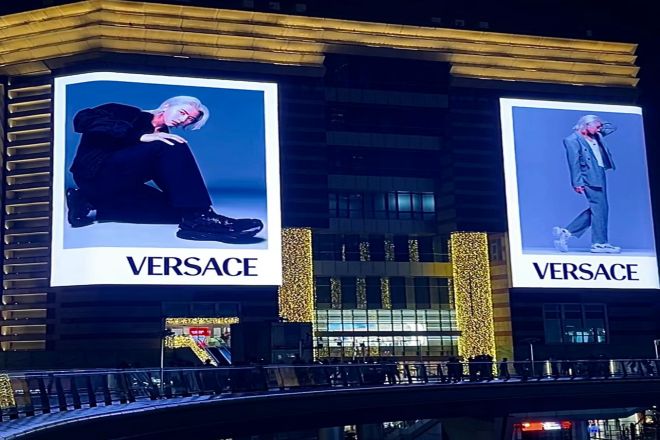
2). Shanghai Bund Light Show LED Display Marketing
2.1). Success factors:
City business card: As one of the iconic landscapes of Shanghai, the light show of Shanghai Bund attracted a large number of tourists and citizens to stop and watch, providing a good display platform for LED display marketing.
Creative fusion: Combining brand elements with urban landscapes to create unique visual effects and enhance the appeal and memory of advertisements.
Technical support: Using advanced LED display technology and control systems to ensure the clarity and fluency of advertising content and enhance the audience’s viewing experience.
2.2). Implementation process:
Site selection evaluation: According to brand positioning and target audience, select a suitable Bund area as the advertising display location.
Content design: Combine the night view of the Bund and urban culture to design advertising content that conforms to the brand image and atmosphere.
Technical preparation: Ensure the installation, debugging and stable operation of the LED display screen, and provide technical support for advertising display.
2.3). Final effect:
Attracted a large number of tourists and citizens to pay attention and take photos, and enhanced the brand’s popularity and reputation.
Through integration with the urban landscape, the connection and identity between the brand and the urban culture are enhanced.
Promoted the increase of brand sales and market share in the local market.
4. Challenges and coping strategies that may be faced in the marketing process
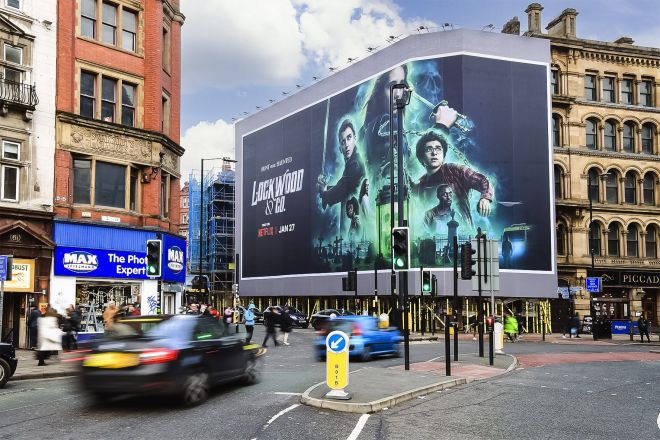
In the LED display industry, companies face many challenges, including technical challenges, budget constraints, and market competition. The following is a detailed analysis of these challenges and coping strategies:
1). Technical challenges and solutions
1.1). Technical challenges:
Improving display effects: As consumers’ requirements for visual experience continue to increase, LED displays require higher resolution, color reproduction, and brightness.
Technological innovation: New display technologies such as Mini LED, Micro LED, OLED, etc. continue to emerge, posing a challenge to traditional LED displays.
Stability and reliability: In complex environments such as outdoors, the stability and reliability of LED displays become key issues.
1.2). Solutions:
Increasing R&D investment: Companies need to continue to increase R&D investment in display technology to improve display effects and meet market demand.
Technology introduction and cooperation: Actively introduce advanced foreign technologies and establish cooperative relationships with domestic universities, research institutions, etc., to jointly promote technological innovation.
Optimize product design: Use advanced heat dissipation technology, drive circuits, and control systems to improve the stability and reliability of LED displays.
2). Budget constraints and coping strategies
2.1). Budget constraints:
Under limited budgets, companies need to balance marketing investment, product development, production and manufacturing, etc. to ensure the optimal allocation of resources.
2.2). Response strategies:
Precision marketing: Through market research and data analysis, accurately locate the target customer group, formulate targeted marketing strategies, and improve marketing efficiency.
Cost control: Optimize the production process, reduce the cost of raw material procurement and manufacturing; at the same time, reduce unit costs through large-scale production.
Flexible financing: Use various financing channels, such as government subsidies, bank loans, venture capital, etc., to alleviate financial pressure.
3). Market competition and maintaining competitive advantage
3.1). Market competition:
The LED display market is highly competitive, and many domestic and foreign brands have flooded into the market. Price wars, technology wars, brand wars and other competitive means are emerging in an endless stream.
3.2). Maintain competitive advantage:
Technological innovation: Continue to promote technological innovation, develop new display technologies with independent intellectual property rights, and enhance product competitiveness.
Brand building: Strengthen brand building and promotion, enhance brand awareness and reputation, and enhance consumer loyalty and trust in the brand.
Differentiated competition: According to market demand and consumer preferences, develop products and services with differentiated competitive advantages to meet the needs of different customer groups.
Market expansion: Actively explore domestic and foreign markets, especially emerging markets and developing countries, and expand market share.
Customer Service: Establish a sound customer service system, provide high-quality pre-sales, in-sales, and after-sales services, and improve customer satisfaction and loyalty.
Conclusion
In summary, formulating and implementing marketing strategies for LED displays is a key step to increase exposure, enhance brand influence, and realize commercial value.
By clarifying goals, innovating content, integrating channels, and responding flexibly to challenges, we can make LED displays a bridge connecting brands and audiences, injecting new vitality into the long-term development of enterprises.
Finally, if you want to know more about LED displays, please get in touch with us.
